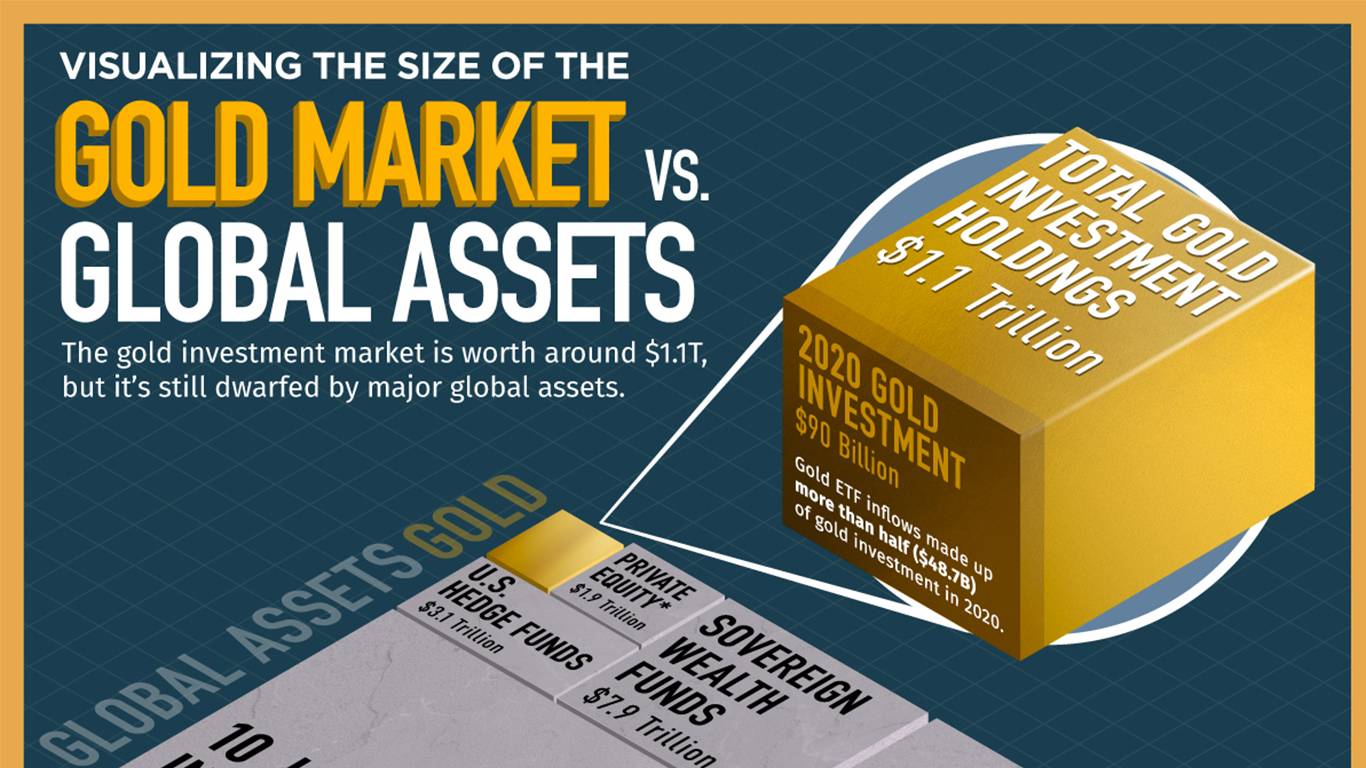Visualizing Gold Investment Compared to Global Assets
How Gold Compares to Global Assets
Gold has been a vital asset for investors and speculators to hedge against uncertainty and currency devaluation, but today it is just a small part of the investment landscape.
While gold investment holdings stand at $1.1T, this figure is dwarfed by various other global assets and funds.
This graphic compares the size of gold investment holdings to global assets, highlighting the difference in dollars invested, and where modern day investors have (or haven’t) been allocating their money.

Gold vs. Global Assets
Despite amounting to over $1 trillion dollars, gold investment holdings are a small fish in the large pond of major global assets.
Largely outsized by private equity funds, hedge funds, and more, gold has taken a backseat for today’s investors when it comes to where they allocate their capital.
| Asset | Value |
|---|---|
| 2020 Gold Investment | $90.0B |
| Total Gold Investment Holdings | $1.1T |
| Top 10 Global Private Equity Funds | $1.9T |
| U.S. Hedge Funds | $3.1T |
| Sovereign Wealth Funds | $7.9T |
| 10 Largest Investment Banks | $32.3T |
| Global Pension Funds | $49.3T |
| 30 Largest U.S. Mutual Funds | $59.0T |
Sources: Mutualfunddirectory.org, Willis Towers, relbanks.com, swfininstitute.org, barclayhedge.com, investopedia.com, CPM, Incrementum AG
Even with 2020’s large inflow of gold investment worth $90 billion, gold investment remains small on the scale of the world’s financial assets.
With its fairly small market, around 90% of gold’s global trading volume flows through three major exchanges, with the remaining volume coming from smaller OTC and secondary markets.
The Major Gold Exchanges Today
Although gold investment has been overtaken by other global assets, it still remains an important investment asset and has one of the most active markets in the world. Gold markets are split among three primary trading hubs which transact millions of dollars in volume every day.
- London Metal Exchange (LME): Established in 1877, the LME offers futures contracts for metals including gold.
- COMEX: A division of the Chicago Mercantile Exchange (CME) COMEX offers physically settled gold futures and options contracts.
- Shanghai Futures Exchange (SHFE) and Shanghai Gold Exchange (SGE): While relatively young, these two exchanges have captured a large amount of gold trading volume, with the SGE being the largest purely physical gold spot exchange in the world.
Gold Exchange Trading Volumes
| Gold Exchange | FY 2020 Trading Volume |
|---|---|
| London Metal Exchange (LME) | $160M |
| COMEX | $54.4B |
| Shanghai Futures Exchange (SHFE) | $6.19B |
| Shanghai Gold Exchange (SGE) | $6.22B |
Source: World Gold Council
These three hubs and four exchanges host the majority of the world’s gold trading, and saw ~$67B worth of gold trading volume in the fiscal year of 2020.
ETFs are Making Gold Investment Accessible
While the exchanges mentioned above transact millions of dollars worth of gold a day, gold-backed ETFs have made gold more accessible to the everyday investor. The top 3 U.S.-traded gold ETFs have more than $94B in assets under management between each other.
These ETFs offer investors one of the easiest ways to get gold exposure in their investment accounts, and see billions in flows every year.
Quarterly Gold ETF Flows
| Region | Q1 2020 | Q2 2020 | Q3 2020 | Q4 2020 | Q1 2021 | Q2 2021 |
|---|---|---|---|---|---|---|
| North America | $6.8B | $18.2B | $11.8B | -$5B | -$8.1B | $1.1B |
| Europe | $8.1B | $4.4B | $3.4B | -$2.1B | -$2.4B | $1.6B |
| Asia | $0.7B | $0.5B | $1.2B | -$0.3B | $1B | -$0.1B |
| Other | $0.3B | $0.5B | $0.4B | -$0.3B | $0.1B | -$0.1B |
| Total | $15.9B | $23.6B | $16.8B | -$7.7B | -$9.4B | $2.5B |
Source: World Gold Council
Last year saw record inflows into gold ETFs, as investors sought a safe haven for their capital during the COVID-19 pandemic. However, gold ETFs have seen an overall outflow of $6.1B in 2021 so far, with North American gold ETFs seeing $402M in outflows just this July.
At the same time, European gold ETFs have seen a recent rise in inflows, highlighting a divergence in sentiment between the two regions. In the month of July, European gold ETFs saw $999M worth of inflows, with Asian gold ETFs also registering positive inflows of $54M.
Central Banks Still Believe in Gold’s Future
While gold is not attracting immediate investment flow into ETFs, the world’s central banks still maintain large amounts of their reserve assets in gold. While they primarily hold gold to hedge against currency depreciation and to diversify their reserves, gold has proved an incredibly valuable investment for central banks over the decades.
Some central banks like the U.S., Germany, and Italy, have more than 50% of their reserves’ dollar value in gold, showing truly how much they value the precious metal.
With the world’s central banks holding around $1.69T worth of gold in their reserves currently, gold remains an essential investment for both big and small players alike.









Add comment